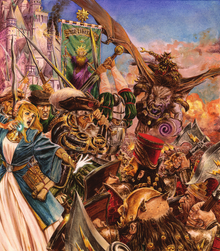Sunna, also known as the Sun Maiden, is a deity worshipped by humans all around Vetia, most prominently in Sonnstahl and Avras. She is the Goddess of the Sun.Sunna is often viewed as part of a pantheon of gods.[1]
It is widely believed that Sunna, or an incarnation of her, came to the Mortal Realm and helped free mankind from the vermin empire, ushering in the Ninth Age. These exploits, and much else, are detailed in the book known as the Sunna Cycle.
History[]
Records suggest that Sunna was worshipped in the Eighth Age by the tribes of the Askar [2], as well as the tribes of the Breidar, the Gjothar, and a dozen smaller groups [3].
Other sources claim that Sunna was worshipped in the ancient Avrasi Empire [1]. The centre of that religion was supposedly the Holy Sepulchre in Avras [1], presumably found in the same place as the modern great Sepulchre.
Worship[]
Sunna is mostly worshipped by humans in Vetia, but it has spread to other pats of the world , even as far as to southern Taphria [4], as well as Virentia [5].
In Vetia, worship of Sunna is found most prominently in Sonnstahl [5], a nation said to be founded upon the exploits of Sunna [6]. In the nations of Destria and Arcalea there are also followers of Sunna, though there often in the mystified form of the saint Themesis [7].
Avras is considered a holy place for the religion of Sunna. It was liberated by her in the Eighth Age and it is said that she blessed the site even when the ancient Avrasi Empire was founded in the Fourth Age. Today, the Great Sepulchre can be found in Avras [8], presumably where the Holy Sepulchre of ancient Avras once stood. [9]
The Church of Sunna[]

Main article: Church of Sunna
The Church of Sunna[10] is a religious organisation found primarily in Vetia.[5] It is widespread in Sonnstahl, and has members even from the royal family there. In Sonnstahl the church is said to wield a considerable amount of power, their Prelates able to act as both politicians and judges. [11]
Presumably the Church of Sunna is in some way connected to the Sunna Cycle, a book which details the Sunna Myth.
Description[]
Sunna is often depicted as a young maiden with long golden hair [2]. She usually wears bronze armour and carries a flaming sword, known as The Sonnstahl. Another common feature associated with Sunna are the Scales of Justices, which she often carries in her other hand [11].

Concept art of Sunna.
Sunna is said to be the Goddess of the Sun [9]. Repeatedly in the tales of the exploits of her avatar, in the Book of Askar, is describes as using the sun to her advantage in battle. Feats such as blinding her foe or melting ice. [2]
The Sonnstahl[]
Main article: The Sonnstahl
The Sonnstahl is the sword wielded by Sunna [6], that she used to slay the Rat King [12]. After the liberation of Avras, the Sonnstahl was kept safe in the Holy Sepulchre [9]. In 201 A.S.[11], the whereabouts of the Sonnstahl were unknown [13].
The Empire of Sonnstahl is named after the sword.[6]
Goddess made flesh[]
Gods and deities are normally said to be constrained to the Immortal Realm [14], yet Sunna is said to have once entered the Mortal Realm and played a direct part in its history [2]. How this is possible is debatable, though is seems reasonable that the form Sunna had in the Mortal Realm was some sort of Avatar of the goddess, as argued below.
The most comprehensive document on the exploits of this avatar of Sunna is most likely the Sunna Cycle. An entire tome dedicated to Sunna Myth.
Battle of the river Gewache[]
Sunna, or her avatar, appeared at the Battle of Gewache River. The Askar king Warin had amassed ninety soldiers to hold a ford of the river, to by the rest of his people time to escape. The foe facing them was Bragh, the Black Bull, and his armies. The battle went poorly for the Askar and while many foes had been slain, Bragh himself was unstoppable. King Warin had lost both horse and shield, and lay before Bragh who readied for the final blow, when a single soldier stepped in front of the king. [2]
The soldier was a woman. She stepped in front of Bragh as the dawn broke, and the sun's light reflected in her sword and bronze breastplate, blinding the beast. Her first blow cut through Bragh's heel, forcing him to down to one knee, where she then sunk the sword deep into his chest. The final blow hit home in the open jaws of Bragh, driving into his skull. With their leader defeater, the rest of the beasts fled. [2]
The survivors of the battle praised the woman, eager to learn her identity. Warin calmed them by falling to one knee before her. Allegedly, he recognised the face of his Goddess from his prayers. Warin offered her his sword, and spoke: [2]
"It is Sunna. She has come."
Sunna's sword is known as the Sonnstahl, it is unknown if this is the sword that was offer to her by Warin or if she acquired it by other means.
Forge of alliances[]
Word of Sunna's arrival and victory over Bragh spread fast. From Equitaine came Uther of Gasconne with a host of knights, who allied with her in defiance of his king, Gilles de Raux, orders. Together they defeated the Ancient One, and drove his armies back into the sea. [15]
Following that, Sunna's army was joined by Queen Genoveva, from the land now known as Destria, and her archers. With her new ally, Sunna pushed into the White Mountains and defeated the orcs and goblins who resided there. This deed earned her the friendship of Arcaleone, from modern Arcalea. [15]
Over time the tribes of the Breidar, Gjothar and Glauca also joined Sunna in her cause. She united all the tribes of humanity. [15]
Battle of the river Volsk[]
Together with her allies, Sunna's next great challange came to be the Battle of the river Volsk. A host of Åsklanders and Makhar under banners of the Dark Gods, as well as ogres and beasts, approached from the east. They met on either side of the river Volsk, seemingly impossible to cross. Until shamans marked by the Dark Gods used their sorcery to freeze the water. Across came first the Åsklanders, who were cut down by the archers of Queen Genoveva. Then the Makhar rode across, but were met by Uther and his knights. [15]
Finally came the Ogres, who seemed unstoppable. In spite of Warin's cries to retreat, Sunna walked to the bank of the river and planted her standard. She spread her arms and looked to the sky, where the clouds parted to let the sun shine down. The ice covering the river began to crumble, and the river washed the enemies away, unfortunately dragging a a few of Genoveva's archers with it. [15]
Conquest of Avras[]

From the tapestry imagery of the Eighth Age in the World Hymn. From left to right featuring: Sunna, Uther and Warin.
The armies of Sunna are said to have celebrated their victories in the halls of Warin. They were approached by a Vermin emissary from their empire in Avras. He proclaimed: "Serve the Empire and be rewarded. Oppose and be destroyed.” [12]
The generals fell into discussion on how to respond, with Warin leading the side urging for acceptance of the terms. Arcaleon opposed and recommended a rejection of the term. Sunna answered by drawing the Sonnstahl and ordering the guards of the emissary be slain. The emissary himself was sent crawling back to Avras with the message: "The Dawn is coming." [12]
Sunna and her army massed for war and marched on Avras. Three armies of vermin were sent in their path, each was defeated, though the losses were mounting. Upon reaching Avras, Warin was approached by the vermin and presented with a sword said to be able to slay a god. He was conflicted but took the blade.[12]
Come dawn, the armies of attacked. Upon the ramparts the Rat King was visible for a short while, before he fled into the city. Uther and Genoveva acted as rearguard against the vermin reinforcements swarming in from all the empire, while Arcaleon accompanied Sunna at the front. Having breached the gates, the battle spread throughout the city. Sunna and her cohort pushed for the throne room in search of the Rat King.[12]
Arriving in the throne room, they were met by a towering monstrosity. The Rat King has swelled to immense proportions, surrounded by dead priests and shards of glowing rock. Sunna and her warriors were attacked by elite rodent bodyguards and had to fight their way to the king. Arcaleon reach him first, but was swiftly slain. Admits the calamity, Warin lost all hope and betrayed Sunna, thrusting the blade he had been given into her side. [12]
This did not stop Sunna though, and she duelled with the Rat King, with the fight moving from the throne room to the ramparts. Both suffered many wounds, but Sunna's strength was fading. With the last of her might she tore the Warin's blade from her body and drove it into the chest of the Rat King, plunging him from the walls. Sunna had won, but shortly thereafter she succumbed to her wounds. [12]
Divinity[]
The true identity of the woman viewed as Sunna, or rather her degree of divinity, is not explored much in the available sources. Generally it is said that gods cannot exist in the Mortal Realm [14], so Sunna herself should not be able to materialise. One could argue though that it is conceivable that the woman known as Sunna was an avatar of the goddess, in some form. A mortal woman somehow infused with the spirit and strength of a deity. This is perhaps supported by the religion in Destria and Arcalea where the saint Themesis is worshipped, a form of mystification of Sunna. Perhaps this Themesis is simply what is here called an avatar. There are also some who suggest similar explanations but with The Lady involved instead. The idea being that the avatar was actually of The Lady and took the name Sunna.
In the Book of Askar, the avatar is described to appear at the Battle of the Gewache River, seemingly out of nowhere, wearing gear and armour that confuses her with the soldiers of Askar. She is described as, or at least compared to, an Askar maiden. This inherently does not prove any divinity, as she could just have been one of Warin's soldiers who became lucky. Warin is however described as being shocked when he realised the solder stepping in front of him was a woman, suggesting that she was not part of the original ninety. Though it is not impossible that his shock was merely due to the woman showing such courage rather than just being there, or that the soldier had thus far disguised herself as a man. It is also possible that the soldier became infused with the power of the goddess during the battle, or that the goddess materialised in a form that the Askar would rally around (thus the armour).
Throughout the Book of Askar, the avatar is also described performing deeds that would seem impossible to a mortal, such as parting clouds and fighting on through deadly wounds. Still, this could merely be the result of happen-stance and exaggeration through the ages. As it happens, in the end the avatar is said to have been killed, as a regular mortal. Though if the body was mortal but the spirit not, this proves nothing.
In the end, much like real world religion, this can be debated endlessly. What is known with a fair deal of certainty though is that she did exist and played a great part in the history of the world, for she is featured in the World Hymn of the Eighth Age [16].
Connection to other deities[]
Sunna is connected to many other deities. Both through her pantheon but also to deities that can be viewed as alternative forms of her.
Sunna's Pantheon[]
Main article: Sunna's Pantheon
In some cultures, Sunna is said to be part of a pantheon of gods [1], here called Sunna's Pantheon due to her being at the forefront of it. It is sometimes called the Sonnstahler Pantheon [17], but that seems inaccurate since the gods part of it were worshipped long before the Empire of Sonnstahl was founded. In general, the pantheon is said to consist of the following gods: Sunna, goddess of the Sun; Volund, the Smith; and Ullor, Father of Winter [2].
Themesis[]
The religion of Destria and Arcales is said to be based in the worship of saints. First of these saints is Themesis, which can be seen as a mystification of Sunna. [7]
Sol[]
Main article: Sol
Sol was the Goddess of Heaven, believed to have been worshipped in ancient Avras [18]. She is described as having grasped the sun to bring light to the world [18]. Other sources suggest Sunna was worshipped by the Avrasi at the time [1]. Given this it seems not unlikely that Sol is an older name for Sunna and that she was indeed worshipped in ancient Avras.
The Lady[]
Main article: The Lady
The Lady is a deity with worshipped widespread in Equitaine. There are supposedly some who consider the Lady the be an alternative name for Sunna, or even that the woman who liberated Avras was merely an incarnation of the Lady. Such suggestions are generally considered as blasphemous though, by worshippers of either goddess. [10]
Sources[]
- ↑ 1.0 1.1 1.2 1.3 1.4 Drusus' letter to the Avrasi, Sunna Cycle, estimated date 59 A.S. (T9A:FB Rulebook, v1.3.5, p136-137)
- ↑ 2.0 2.1 2.2 2.3 2.4 2.5 2.6 2.7 The Book of Askar: chapter 1, Sunna Cycle (T9A:FB Rulebook, v1.3.5, p3)
- ↑ Interview with Sigmund Selig, the Great Sage, second session (The 9th Scroll, issue 4, p20)
- ↑ Letter from famed explorer and missionary Erik Tombstone (The 9th Scroll, issue 7, p4)
- ↑ 5.0 5.1 5.2 Johannes Strabo; A New Atlas for the Ninth Age (T9A:FB Rulebook, v1.3.5, p124)
- ↑ 6.0 6.1 6.2 Jorge Zamoran; An account of the peoples, nations and monsters which inhabit the world: The Empire of Sonnstahl (T9A:FB Rulebook, v1.3.5, p141)
- ↑ 7.0 7.1 Informative text about Arcalea (The 9th Scroll, issue 7, p6)
- ↑ Diary of Claude le Petit, entry from Tandemar 3rd, 962 A.S. (T9A:FB Rulebook, v1.3.5, p133)
- ↑ 9.0 9.1 9.2 Drusus' letter to the Avrasi, Sunna Cycle, estimated date 59 A.S. (T9A:FB Rulebook, v1.3.5, p136-137)
- ↑ 10.0 10.1 Interview with Sigmund Selig, the Great Sage, first session (The 9th Scroll, Issue 3, p13)
- ↑ 11.0 11.1 11.2 Informative text about the Empire of Sonnstahl (The 9th Scroll, issue 5, p36)
- ↑ 12.0 12.1 12.2 12.3 12.4 12.5 12.6 The Book of Askar: chapter 14, Sunna Cycle (T9A:FB Rulebook, v1.3.5, p146-147)
- ↑ Leopold Truehearted (201 A.S.) Brothers and Sisters of the Goddess (The 9th Scroll, issue 5, p36)
- ↑ 14.0 14.1 Verdorben Kantu (784 A.S.) Immortal Beings and Where to Find Them (T9A:FB Rulebook, v1.3.5, p134)
Cite error: Invalid
<ref>tag; name ":2" defined multiple times with different content - ↑ 15.0 15.1 15.2 15.3 15.4 The Book of Askar: chapter 5, Sunna Cycle (T9A:FB Rulebook, v1.3.5, p64)
- ↑ The World Hymn: The 8th Age (T9A:FB Rulebook, v1.3.5, p130)
- ↑ On races and their magic (The 9th Scroll, issue 5, p8)
- ↑ 18.0 18.1 The Timeless Titans; inscription found in one of the oldest temples of Avras (T9A:FB Warriors of the Dark Gods, v0.201.0, p20)
19. Sunna statue reproduction